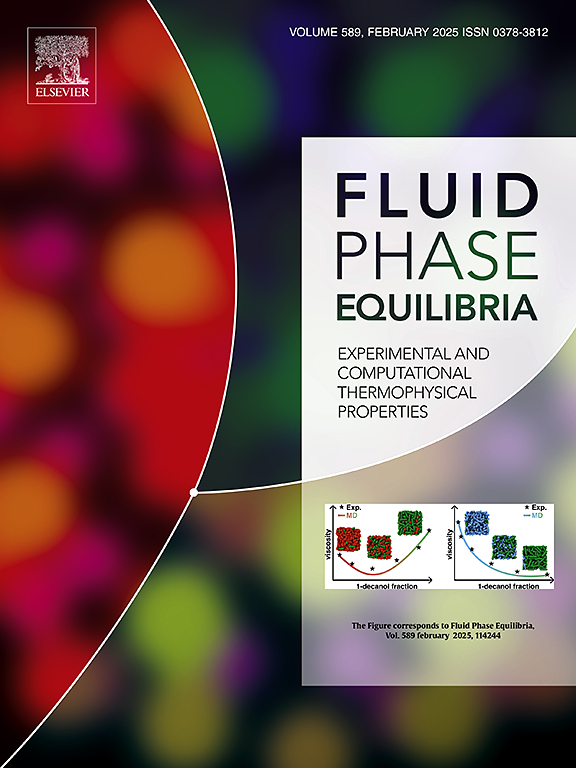Synthesis of CO2 hydrate capsules in partially water-saturated sediment as vessels for underground mechanical energy storage: Promoting effect of tetrahydrofuran and cyclopentane
IF 2.8
3区 工程技术
Q3 CHEMISTRY, PHYSICAL
引用次数: 0
Abstract
The intermittency of renewable energy sources and the increase in renewable energy shares require energy storage capability to sustain the green transition. One promising solution for underground energy storage is the use of subsurface CO2 hydrate capsules, which act as impermeable vessels that store compressed fluids and discharge them upon need. However, as part of the proof-of-concept study of this technology, the feasibility of constructing such vessels, e.g. CO2 hydrate capsules, has yet to be demonstrated. This work employed CO2 gas injection assisted by chemical solution into partially water-saturated sand sediments to synthesize CO2 hydrate capsules. The concentrations of chemical solutions (THF, CP and DIOX) were screened out in the gas/liquid/sand system in terms of kinetic promotion, using a rocking cell. Separately, experiments were carried out with a new high-pressure chamber set-up that quantified the effects of water saturation and chemical promoters on the efficiencies of CO2 hydrate synthesis in confined partially water-saturated sand. Results on the gas/liquid/sand system showed that 0.025 water/CP weight ratio CP solution and 1.3mol% THF solution induced the largest pressure drops of 18.4 ± 0.2 bar and 16.7 ± 0.1 bar, respectively, indicating the most promoted CO2 hydrate formation kinetics. Results with the pressure chamber showed three stages during slow CO2 gas injection: (1) initial pressure “build-up stage”; subsequent (2) CO2 gas “uptake stage”; and (3) CO2 injection “closing stage”. CO2 hydrate formation kinetics of CO2 hydrate retention percentage (SCO2) and CO2 hydrate density (ρCO2) were directly proportional to the initial water saturation (6.0–76.7%). Injection of THF or CP solutions increased SCO2 by 16.5% or 18.5%, and ρCO2 by 74.5% or 128.3% compared to injection of water. The best performances were obtained at a fluid pressure of 27.0 bar, with a 0.025 water/CP solution-assisting CO2 gas injection, in sediment with an initial water saturation of 32.6% and porosity of 44.6%, giving rise to SCO2 of 67.2% and ρCO2 of 80.6%. These findings demonstrated that the injection of THF or CP solution with CO2 gas facilitated the possibility of the formation and stabilization of subsurface CO2 hydrate capsules.

求助全文
约1分钟内获得全文
求助全文
来源期刊

Fluid Phase Equilibria
工程技术-工程:化工
CiteScore
5.30
自引率
15.40%
发文量
223
审稿时长
53 days
期刊介绍:
Fluid Phase Equilibria publishes high-quality papers dealing with experimental, theoretical, and applied research related to equilibrium and transport properties of fluids, solids, and interfaces. Subjects of interest include physical/phase and chemical equilibria; equilibrium and nonequilibrium thermophysical properties; fundamental thermodynamic relations; and stability. The systems central to the journal include pure substances and mixtures of organic and inorganic materials, including polymers, biochemicals, and surfactants with sufficient characterization of composition and purity for the results to be reproduced. Alloys are of interest only when thermodynamic studies are included, purely material studies will not be considered. In all cases, authors are expected to provide physical or chemical interpretations of the results.
Experimental research can include measurements under all conditions of temperature, pressure, and composition, including critical and supercritical. Measurements are to be associated with systems and conditions of fundamental or applied interest, and may not be only a collection of routine data, such as physical property or solubility measurements at limited pressures and temperatures close to ambient, or surfactant studies focussed strictly on micellisation or micelle structure. Papers reporting common data must be accompanied by new physical insights and/or contemporary or new theory or techniques.
 求助内容:
求助内容: 应助结果提醒方式:
应助结果提醒方式:


